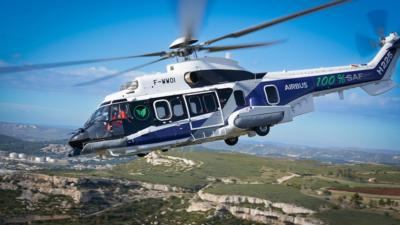Thu, Nov 11, 2021
Continuing Sustainable Fuel Work at Marignane Shows Progress
Airbus completed the first ever helicopter flight using 100% sustainable aviation fuel as part of its SAF development. As the aviation industry around the world looks to upcoming emissions, sustainability, and environmental targets, manufacturers are preparing for alternative fuels to take the stage from traditional petrochemical fuels. Airbus has launched a user group dedicated to the evaluation and integration of SAF into the rotary-wing community.

It has been a banner year for sustainable fuel, with rotorcraft competitor Bell Canada announcing the use of blended SAF in its training, transit, and customer delivery operations, with efforts to move to 100% SAF in the near future. Changing fuels is never an entirely simple process in aircraft, as safety and reliability are paramount, but stakeholders are confident it is the way forward for the industry. Airbus specifically publicized their use of the unadulterated fuel, no small feat when the currently approved SAF blend is capped at 50%.
The flight campaign successfully flew with an unblended SAF, provided by TotalEnergies, derived from used cooking oil. The H225 test helicopter apparently functioned well, and boasted a 90% CO2 reduction compared to regular jet fuel. Continued use and testing will prove what effects a longer-term flight regime has on the aircraft, but Airbus chief technical officer Stefan Thome, sounds optimistic.
“While all Airbus helicopters are certified to fly with up to a 50% blend of SAF mixed with kerosene, it is our Company’s ambition to have its helicopters certified to fly with 100% SAF within the decade. Today’s flight is an important first step towards this goal”, said Thome.
“SAF is an important pillar of Airbus Helicopters’ decarbonisation strategy because it provides immediate CO2 reduction with no negative impact on the performance of the helicopter,” he added. “I thank our partners Safran Helicopter Engines and TotalEnergies for their important collaboration in making today’s flight a reality. Further cooperation among all industry stakeholders is essential to overcome the challenges associated with implementing SAF widely and to make real progress in reducing the aviation industry’s CO2 emissions”.
More News
During The Forced Landing, The Airplane’s Float Struts And Spreaderbars Collapsed Analysis: While en route to a remote fishing lodge in a float-equipped airplane, one of the >[...]
"X-59 is a symbol of American ingenuity. The American spirit knows no bounds. It's part of our DNA – the desire to go farther, faster, and even quieter than anyone has ever g>[...]
Aero Linx: The Honourable Company of Air Pilots The advancement of the public interest by the promotion of safety for all those who are employed in connection with or who travel by>[...]
Minimum Friction Level The friction level specified in AC 150/5320-12, Measurement, Construction, and Maintenance of Skid Resistant Airport Pavement Surfaces, that represents the m>[...]
Aero Linx: Aerospace Industries Association (AIA) For over 100 years, the American aerospace and defense industry has shaped the world around us. From the first flight to the moon >[...]
 NTSB Final Report: Dehavilland DHC-2 MK 1
NTSB Final Report: Dehavilland DHC-2 MK 1 Aero-News: Quote of the Day (10.29.25)
Aero-News: Quote of the Day (10.29.25) ANN's Daily Aero-Linx (10.29.25)
ANN's Daily Aero-Linx (10.29.25) ANN's Daily Aero-Term (10.30.25): Minimum Friction Level
ANN's Daily Aero-Term (10.30.25): Minimum Friction Level ANN's Daily Aero-Linx (10.30.25)
ANN's Daily Aero-Linx (10.30.25)



